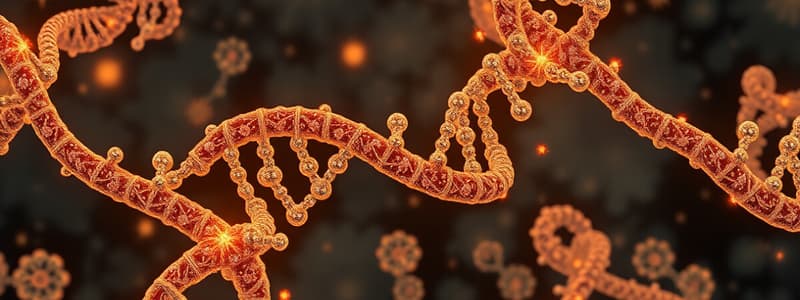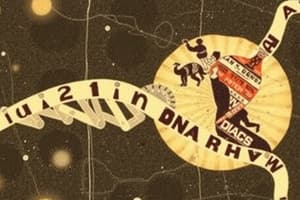Podcast
Questions and Answers
What is the primary reason fibroblasts from older individuals replicate fewer times than those from younger individuals?
What is the primary reason fibroblasts from older individuals replicate fewer times than those from younger individuals?
- Older cells can utilize more nutrients.
- Younger cells utilize energy more efficiently.
- Older cells have shorter telomeres. (correct)
- Younger cells have more active telomerase.
Which end of the chromosome is associated with the folding of telomeres?
Which end of the chromosome is associated with the folding of telomeres?
- Terminal end
- Middle end
- 3′ end (correct)
- 5′ end
What happens to the chromosomes during the replicative cycle in relation to telomeres?
What happens to the chromosomes during the replicative cycle in relation to telomeres?
- Telomeres are completely removed.
- Chromosomes lengthen and become more stable.
- Telomeres regenerate after each cycle.
- Ends of chromosomes become shorter. (correct)
In which type of cells is telomerase typically found, promoting more replicative capability?
In which type of cells is telomerase typically found, promoting more replicative capability?
What role do telomeres play in cellular aging?
What role do telomeres play in cellular aging?
What is a consequence of primer DNA not being removed during replication?
What is a consequence of primer DNA not being removed during replication?
Which statement correctly describes how telomeres interact with the replication process?
Which statement correctly describes how telomeres interact with the replication process?
What is the primary function of the telomerase enzyme?
What is the primary function of the telomerase enzyme?
Which statement correctly describes telomerase function?
Which statement correctly describes telomerase function?
In the context of reverse transcriptase, which of the following statements is accurate?
In the context of reverse transcriptase, which of the following statements is accurate?
What is the significance of telomeres in cellular aging?
What is the significance of telomeres in cellular aging?
Which of the following accurately describes the packing of DNA in a human cell?
Which of the following accurately describes the packing of DNA in a human cell?
What role does the phosphate backbone play in the structure of DNA?
What role does the phosphate backbone play in the structure of DNA?
Which aspect of HIV's mechanism of infection is incorrectly stated?
Which aspect of HIV's mechanism of infection is incorrectly stated?
Which of the following describes the components of telomeres?
Which of the following describes the components of telomeres?
What is the function of the domain in telomerase that reads RNA and polymerizes DNA?
What is the function of the domain in telomerase that reads RNA and polymerizes DNA?
What is the primary role of histones in relation to DNA?
What is the primary role of histones in relation to DNA?
How does telomerase contribute to cellular longevity?
How does telomerase contribute to cellular longevity?
Which of the following statements about telomeres is false?
Which of the following statements about telomeres is false?
What characterizes the enzyme telomerase in relation to DNA synthesis?
What characterizes the enzyme telomerase in relation to DNA synthesis?
Which histone types form the octameric structure essential for nucleosome formation?
Which histone types form the octameric structure essential for nucleosome formation?
Flashcards
What are telomeres?
What are telomeres?
The ends of chromosomes that become shorter with each cell division. They are rich in specific DNA sequences and associated with proteins.
What is shortening of telomeres?
What is shortening of telomeres?
A process that occurs when DNA replicates. The new strand at the 5' end is shortened due to the removal of a primer.
What is the purpose of telomeres?
What is the purpose of telomeres?
They protect the chromosome ends from degradation and prevent the loss of essential genes.
What is replicative capacity?
What is replicative capacity?
Signup and view all the flashcards
What is telomerase?
What is telomerase?
Signup and view all the flashcards
Why do some cells have active telomerase?
Why do some cells have active telomerase?
Signup and view all the flashcards
What did the experiment with fibroblast cells show?
What did the experiment with fibroblast cells show?
Signup and view all the flashcards
What is cellular aging?
What is cellular aging?
Signup and view all the flashcards
What are histones?
What are histones?
Signup and view all the flashcards
What is a histone octamer?
What is a histone octamer?
Signup and view all the flashcards
How does DNA get packed into chromosomes?
How does DNA get packed into chromosomes?
Signup and view all the flashcards
How does telomerase function?
How does telomerase function?
Signup and view all the flashcards
What's the link between telomerase and cancer?
What's the link between telomerase and cancer?
Signup and view all the flashcards
What is reverse transcriptase?
What is reverse transcriptase?
Signup and view all the flashcards
How does HIV use reverse transcriptase?
How does HIV use reverse transcriptase?
Signup and view all the flashcards
What is DNA packing?
What is DNA packing?
Signup and view all the flashcards
How is DNA packed?
How is DNA packed?
Signup and view all the flashcards
Study Notes
DNA Organization Part 1
- DNA is organized into a double helix structure
- Nucleosomes are structures formed by DNA wrapped around histone proteins
- Linker DNA connects nucleosomes
- The DNA double helix is packaged into chromatin fibers
- Chromosomes are duplicated chromosomes
Telomeres
- Fibroblasts from older individuals replicate fewer times than younger individuals, due to shorter telomeres
- Telomeres are repetitive nucleotide sequences at the ends of chromosomes
- Telomere shortening occurs with each cell division; eventually the ends are lost and the cell stops replicating
- Telomeres protect the ends of chromosomes from damage and fusion with other chromosomes
- Telomeres are rich in T and G nucleotide sequences
- The 3' end is longer than the 5' end and folds back on itself
- The 5' end is shorter because enzymes read 3' to 5'
Telomerase
- Telomerase is an enzyme found in cells with high replicative potential
- It adds repetitive sequences to the telomeres
- It is an RNA-dependent DNA polymerase
- The RNA component of telomerase acts as a template for adding DNA to the telomere, thereby extending it.
- When telomerase is active it elongates the end of the DNA molecule, enabling more replicative cycles
- Telomerase is usually present in cells like zygotes, germ cells and cancer cells
- Telomerase is pathologically present in cancer cells, allowing them to bypass cellular aging, enabling proliferation
- The reverse transcriptase domain of the telomerase enzyme reads RNA and polymerizes DNA
- The RNA domain of the enzyme undergoes hydrogen bonding with the 3' end of the telomere.
DNA Packing
- The total length of DNA in a single cell is about 1 meter
- DNA is packed into chromosomes, condensing it about 8000 times
- DNA is packaged using histone proteins.
- Histones are positively charged proteins which bind to the negatively charged DNA backbone.
- Histones form nucleosomes; eight histone proteins (two each of H2A, H2B, H3, and H4) form an octamer, around which DNA wraps
Reverse Transcriptase
- HIV uses reverse transcriptase to convert its RNA genome into DNA, which is then integrated into the host cell's genome.
- Reverse transcriptase is present in telomerase, which adds DNA to telomeres
Studying That Suits You
Use AI to generate personalized quizzes and flashcards to suit your learning preferences.




